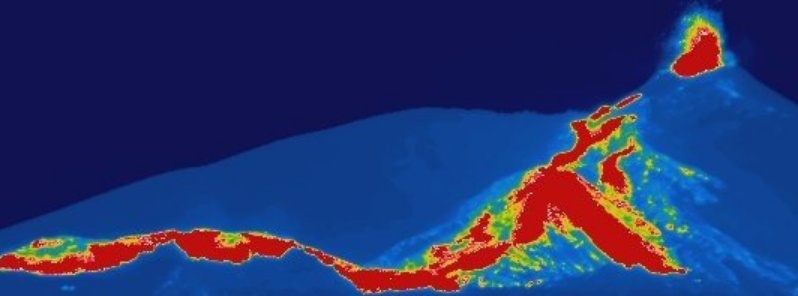Strombolian activity at Pacaya, ash and lava flow observed, Guatemala

Strombolian activity continues at Guatemala's Pacaya volcano, with volcanic material spewed up to 100 m (328 feet) high, according to the National Institute of Seismology, Volcanology, Meteorology, and Hydrology (INSIVUMEH) on Monday, July 13, 2020. Lava flows were also observed from the volcano on Saturday and Sunday, July 11 and 12, up to 800 m (2 625 feet) in length.
The activity of the Mackenney crater with white fumarole in a northwesterly direction was reported on Saturday. This was accompanied by explosions at about 75 to 100 m (246 to 328 feet). By evening, a lava flow of about 800 m (2 625 feet) was observed.
It flowed into two directions– one to the north and the other to the northeast. Seismic stations also recorded tremors associated with the rise of magma, gas, and movement of lava flows.
On Sunday, July 12, the Mackenney crater emitted white smoke that dispersed to the west and northwest. Strombolian-type explosions were also recorded, with incandescent material spewed from 50 to 75 m (164 to 246 feet) above the crater.
It generated a lava flow about 300 m (984 feet) that went northeast, while another to the north. Seismic stations registered constant tremors associated with the rise of magma, as well as the degassing in the crater.
INSIVUMEH noted white smoke from the crater on Monday, which spread to the south and southwest. Strombolian explosions occurred in the early morning and at night, with volcanic material emitted 50, 75, and 100 m (164, 246, and 328 feet) high.
Seismic stations also registered tremors associated with the rise of gases and magma. Two active lava flows were observed, which headed southwest and northwest.
Actividad estromboleana del Volcán de Pacaya, 11/07/2020. pic.twitter.com/NpEuKb8IPc
— Wotzbely Suárez (@Wotzbely) July 12, 2020
Actividad Estromboliana y Flujo de lava del Volcán Pacaya e imágen con cámara inflarroja, el día 11 de Julio pic.twitter.com/jzRFixygQL
— William Chigna (@William_Chigna) July 12, 2020
Espectacular el Volcán de Pacaya está noche.
fotos El Express pic.twitter.com/OWxXZllcbp— Pampichí News (@PampichiNews) July 12, 2020
Pacaya pic.twitter.com/4Wuv3sq4Ia
— Wotzbely Suárez (@Wotzbely) July 12, 2020
Geological summary
Eruptions from Pacaya, one of Guatemala's most active volcanoes, are frequently visible from Guatemala City, the nation's capital. This complex basaltic volcano was constructed just outside the southern topographic rim of the 14 x 16 km (8.7 x 9.9 miles) Pleistocene Amatitlán caldera. A cluster of dacitic lava domes occupies the southern caldera floor.
The post-caldera Pacaya massif includes the ancestral Pacaya Viejo and Cerro Grande stratovolcanoes and the currently active Mackenney stratovolcano.
The collapse of Pacaya Viejo between 600 and 1 500 years ago produced a debris-avalanche deposit that extends 25 km (15 miles) onto the Pacific coastal plain and left an arcuate somma rim inside which the modern Pacaya volcano (Mackenney cone) grew.
A subsidiary crater, Cerro Chino, was constructed on the NW somma rim and was last active in the 19th century.
During the past several decades, activity has consisted of frequent strombolian eruptions with intermittent lava flow extrusion that has partially filled in the caldera moat and armored the flanks of Mackenney cone, punctuated by occasional larger explosive eruptions that partially destroy the summit of the growing young stratovolcano. (GVP)
Featured image credit: University of Bristol

Commenting rules and guidelines
We value the thoughts and opinions of our readers and welcome healthy discussions on our website. In order to maintain a respectful and positive community, we ask that all commenters follow these rules.